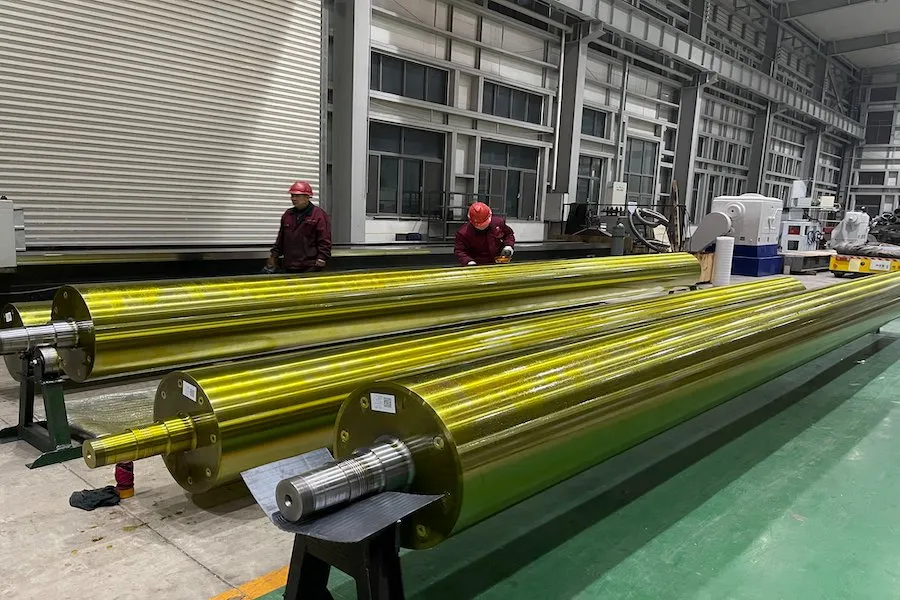What is Roll Deflection?
Roll deflection refers to the bending or deformation of a roll under load, primarily the pressure exerted during the papermaking process. This bending, while seemingly minute, can have significant repercussions on the uniformity of the paper web, affecting properties like thickness (caliper), density, and strength. Imagine trying to flatten dough with a rolling pin that bends in the middle – you'd end up with an uneven result. Similarly, deflected rolls lead to uneven pressure distribution across the paper web.Factors Affecting Roll Deflection
Several factors contribute to roll deflection, including the material properties of the roll (its stiffness and modulus of elasticity), the roll geometry (length and diameter), the applied load (nip pressure), and the supporting structure. Understanding these factors is crucial for predicting and controlling deflection. For example, a longer roll is more prone to deflection than a shorter one under the same load.The Impact on Paper Formation
Roll deflection directly influences the pressure distribution across the nip, the area where two rolls press together to consolidate the paper web. Uneven pressure results in variations in paper caliper, leading to inconsistencies in paper properties. This can manifest as uneven density, weak spots, or variations in surface smoothness. In extreme cases, excessive roll deflection can even lead to web breaks.Measuring and Analyzing Roll Deflection
Accurately measuring roll deflection is essential for effective control. Various methods exist, including direct measurement using displacement sensors and indirect methods based on pressure profiles. Modern paper machines often employ sophisticated scanning systems to map the nip pressure profile and infer the degree of roll deflection. Analyzing this data allows operators to identify potential problems and adjust machine parameters accordingly.Mitigating Roll Deflection: Best Practices
So, how do we minimize the negative impacts of roll deflection? Several strategies can be employed, including:1. Optimized Roll Design:
Choosing rolls made of stiffer materials with higher modulus of elasticity can significantly reduce deflection. Furthermore, optimizing the roll geometry, such as using crowned rolls, can compensate for deflection under load.2. Controlled Nip Pressure:
Carefully controlling the nip pressure is vital. Excessive pressure exacerbates deflection, while insufficient pressure compromises paper consolidation. Finding the optimal balance is key.3. Effective Supporting Structures:
Robust supporting structures, such as well-designed bearings and frames, play a crucial role in minimizing deflection by providing adequate support for the rolls.4. Advanced Control Systems:
Modern paper machines often incorporate advanced control systems that automatically adjust machine parameters to compensate for roll deflection and maintain uniform caliper. These systems can significantly improve paper quality and consistency.Roll Deflection and Caliper Control: A Critical Relationship
One of the most significant consequences of roll deflection is its impact on caliper control. Uneven nip pressure, caused by deflection, directly translates to variations in paper thickness. This is why understanding and managing roll deflection is paramount for achieving consistent caliper and overall paper quality. Think about it: would you be satisfied with a ream of paper where each sheet had a different thickness?Troubleshooting Roll Deflection Issues: A Practical Approach
When facing issues related to roll deflection and paper formation, a systematic troubleshooting approach is essential. Start by thoroughly inspecting the rolls for any signs of damage or wear. Next, analyze the nip pressure profile and look for inconsistencies. Finally, review the machine settings and consider adjustments to roll design, nip pressure, or supporting structures.Looking Ahead: Future Trends in Roll Deflection Management
The paper industry is constantly evolving, and so are the technologies for managing roll deflection. Emerging trends include the development of even stiffer and more durable roll materials, as well as more sophisticated control systems utilizing artificial intelligence and machine learning to predict and compensate for deflection in real-time.How do you currently address roll deflection in your papermaking process? What challenges have you encountered?
By understanding and actively managing roll deflection, paper manufacturers can significantly improve paper formation, caliper control, and overall product quality. This guide provides a foundation for implementing effective strategies to minimize the negative impacts of roll deflection and achieve consistent, high-quality paper production. Take the next step towards optimized papermaking by evaluating your current practices and exploring the solutions outlined above.



